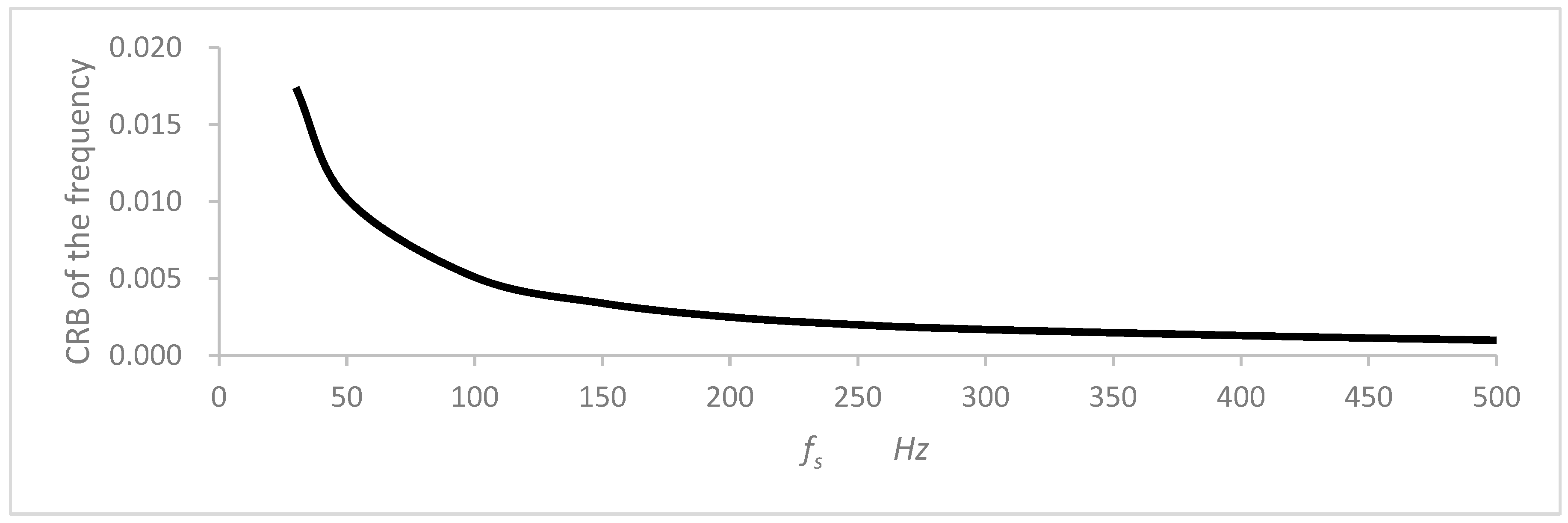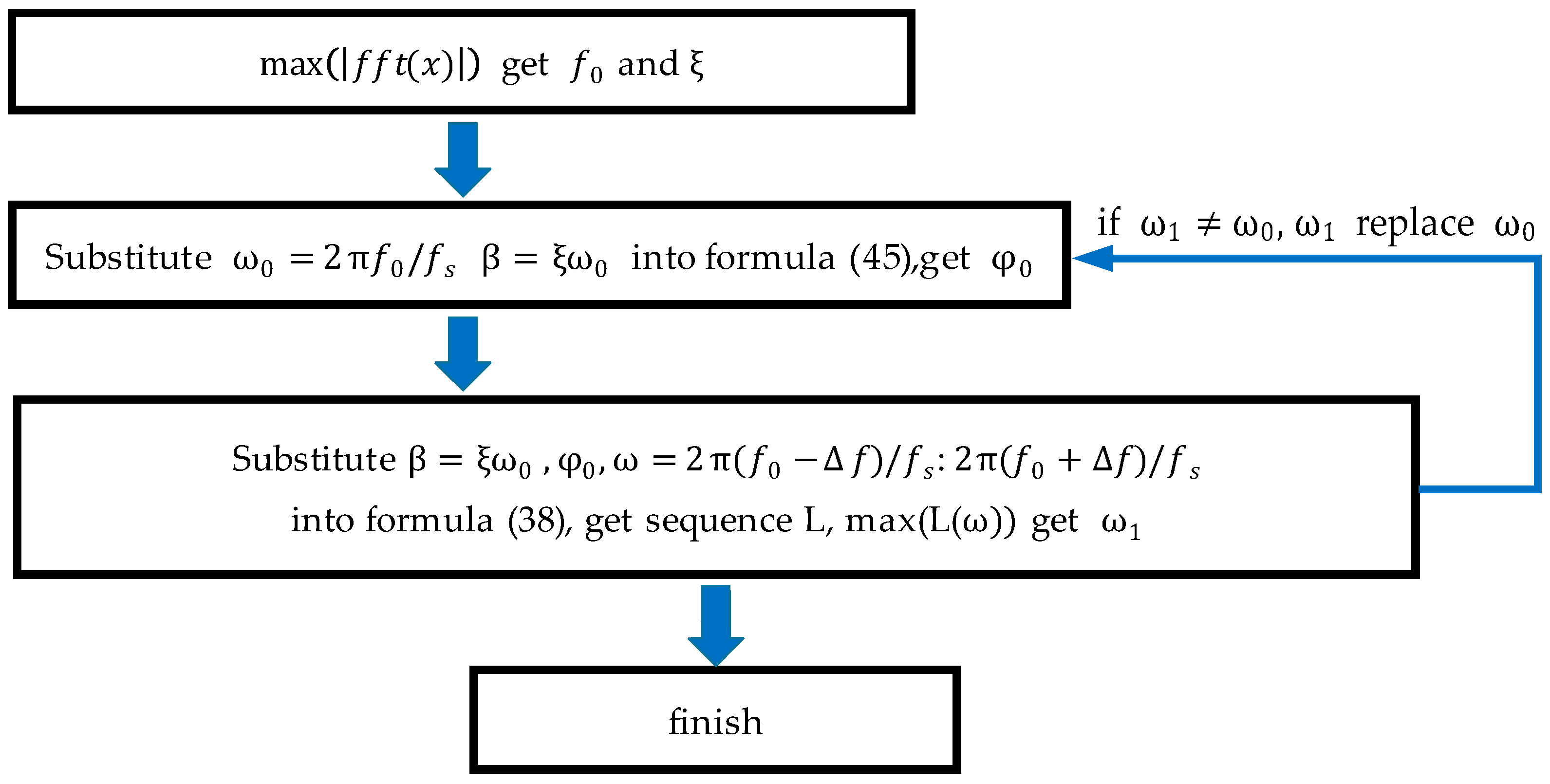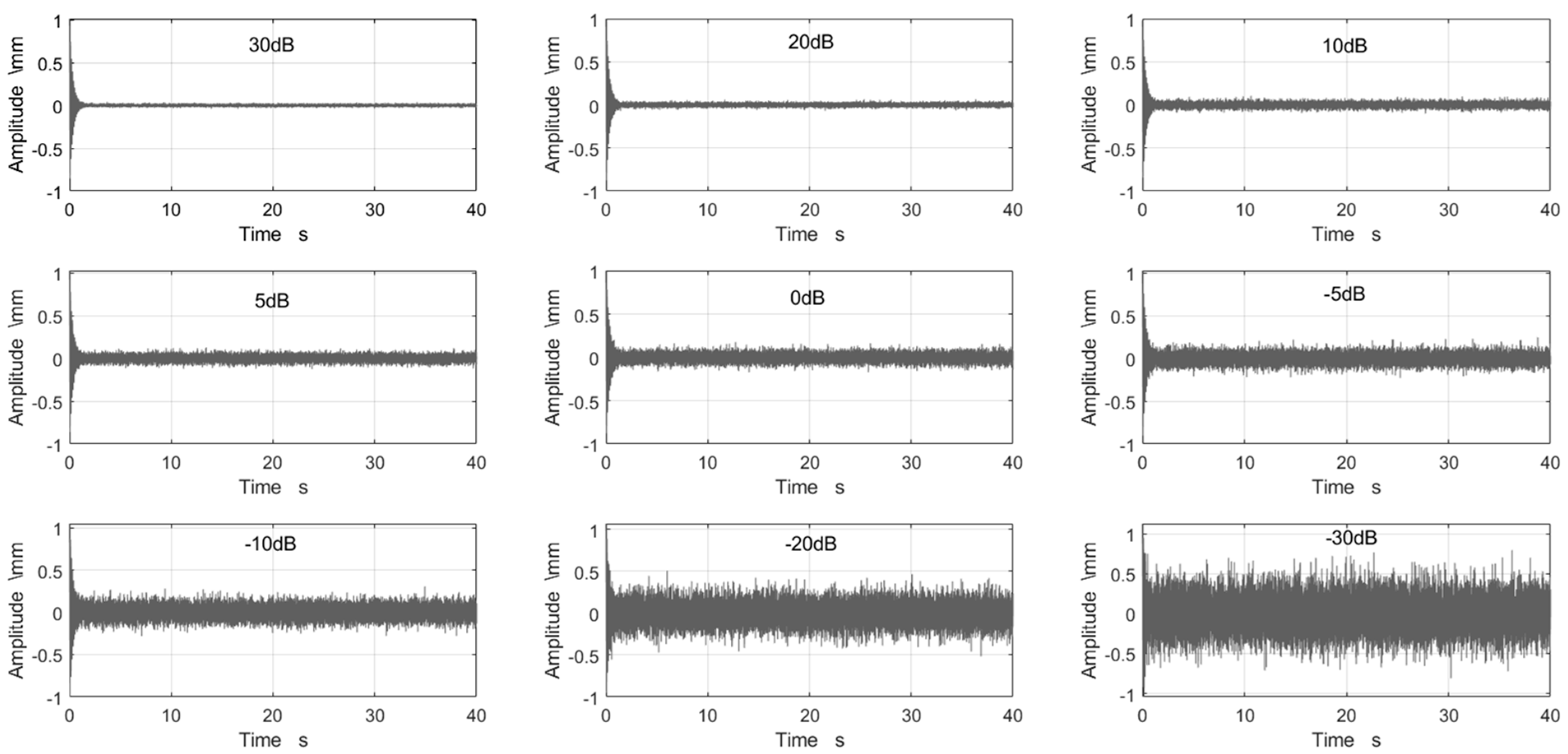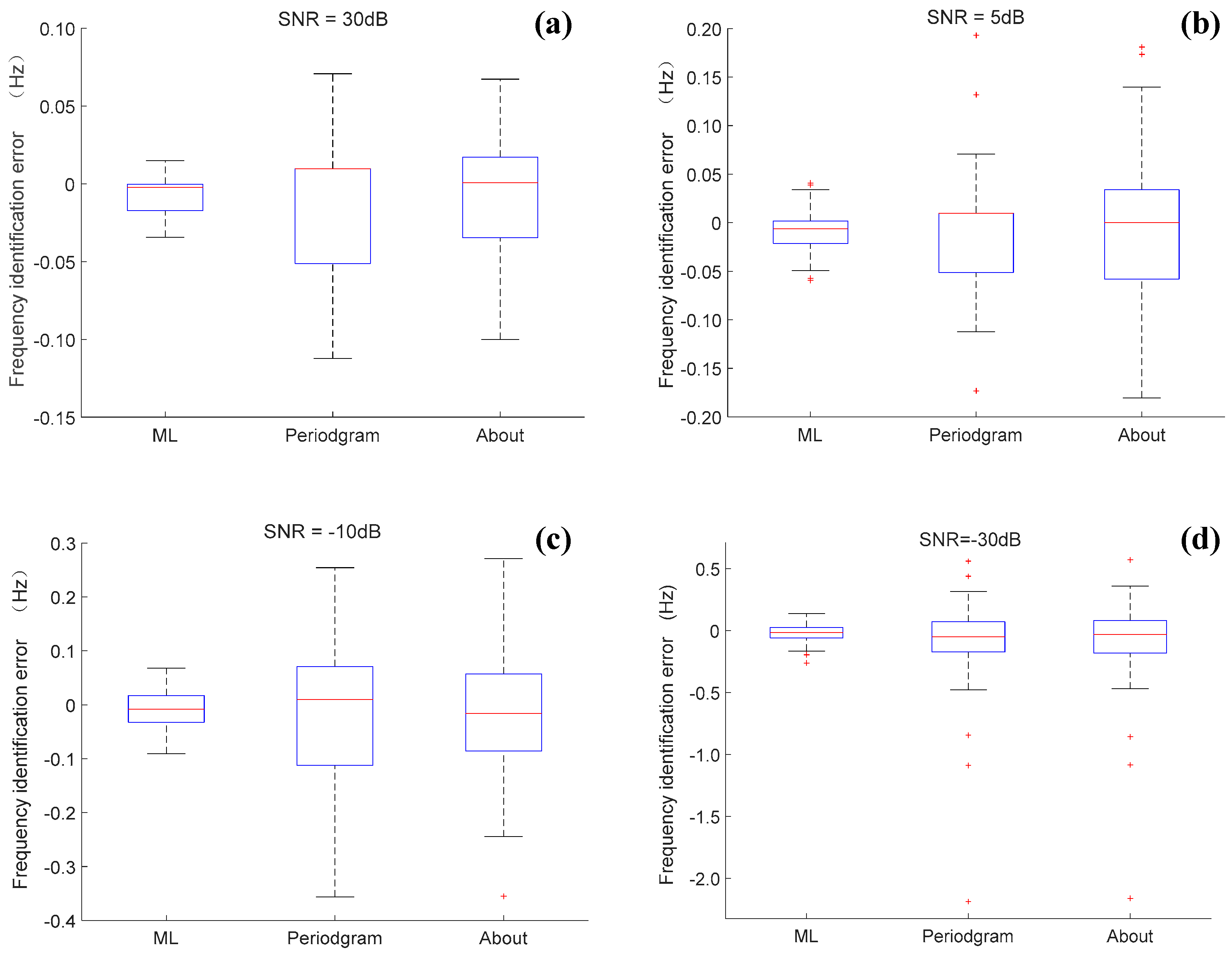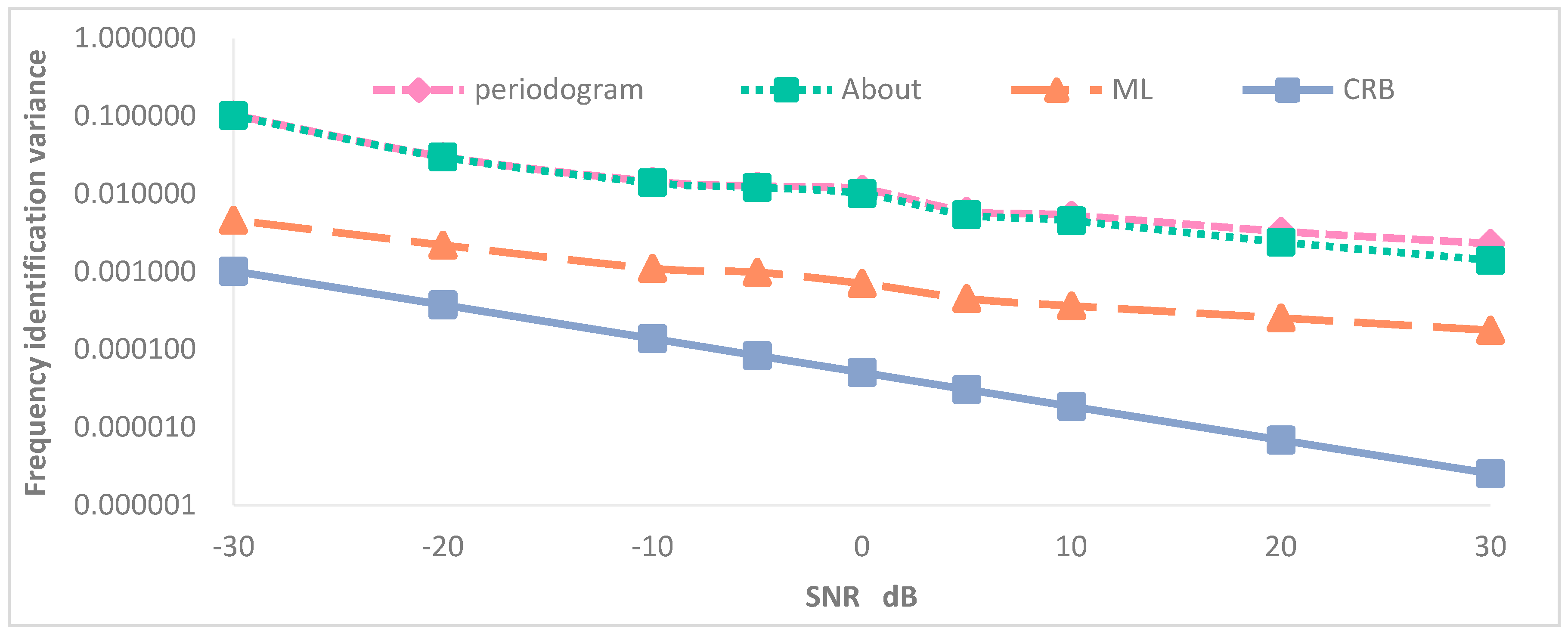2.2.1. Single-Frequency Free Damping Vibration Signal
SFFDVS is described as follows:
where a,
, and
are the amplitude, damping ratio, frequency, and phase of the signal, respectively.
When
,
. Energy integration is performed on s(t), and the integration formula is as follows:
Equation (8) indicates that the single-frequency free attenuation signal possesses limited energy. When SFFDVS combines with the white noise signal, the SNR across the entire domain becomes zero due to the infinite energy of the white noise signal. The genuine free attenuation signal is a finite sequence signal. Its SNR is the free attenuation signal energy ratio to the noise signal energy over the observation time, T.
Equation (7) is discretely sampled, and N sample values are obtained, forming the discrete sequence.
where
is the sampling frequency.
It is assumed that Gaussian white noise z(n) is mixed into the signal s(n); if x(n) = s(n) + z(n), the signal sequence is
where
is a Gaussian noise sample with zero mean and variance
.
The energy integration of
is
Expanding the above formula yields
When the sampling length is long enough, then
. When the system is a small damping system, based on the sampling theorem
,
. If it defines
, then
Based on Taylor’s expansion,
, and by substituting into Equation (13), it can be derived that
The SNR of a noisy single-degree-of-freedom free attenuation signal can be obtained as follows:
If the sampling time is
, then
Based on the analysis, the free attenuation vibration signal exhibits the following characteristics:
The free attenuation vibration signal is energy-limited; as t approaches infinity, approaches zero. As the sampling time extends, the SNR decreases; when the sample time, T, approaches infinity, the SNR, , approaches zero.
The SNR of the free attenuation signal is directly proportional to the sampling frequency and the square of the initial amplitude. It is inversely proportional to the damping ratio, signal frequency, and sampling length.
The primary parameters of a single-frequency free attenuation signal encompass the initial amplitude, damping coefficient, frequency, and phase angle. The frequency and damping coefficient are the main parameters of interest in practical engineering applications.
2.2.2. CRLB of Single-Frequency Free Damping Vibration Signal
The parameter estimation model of SFFDVS is given by Equation (9). For convenience of calculation, normalization is conducted. This study considers
and
; thus,
where
are unknown, and
.
From the parameter estimation model, the following can be derived:
The probability density function is presented as follows:
The joint probability density function is described as follows:
and
The unbiased CR bounds consist of the diagonal elements of the inverse of the Fisher information matrix, J. When
represents a Gaussian noise sample with a zero mean and a variance of
, the Fisher information matrix is as follows [
34]:
The following can be derived based on Equation (22):
where
,
The Fisher information matrix is symmetric; thus:
Based on Fisher’s matrix, the CRLB of the parameters can be estimated.
After normalization processing with
, the following is derived:
Hence, obtaining the analytic formula for the inverse matrix of the Fisher matrix proved challenging. A simulation analysis was conducted to better understand the identification accuracy of the parameters under consideration.
2.2.3. Characteristics of CRLB of Single-Frequency Free Damping Vibration Signal
Four simulation groups were established to examine the effects of sampling frequency, phase angle, damping coefficient, and noise on recognition accuracy, each assessing the impact of distinct parameters.
- (1)
Influence of sample frequency on frequency identification accuracy
Assuming that a = 1.0
,
,
, the noise signal variance
, and the data sampling length
, then
. The Fisher matrix was determined, and subsequently, the CRLB of the frequency was estimated using Equation (36) by substituting these parameters into Equations (23)–(33). The computed results are listed in
Table 1, with a corresponding visual representation in
Figure 2.
The CRLB of a real sinusoidal signal is
where
is the SNR (
); N is the length of the data.
The CRLB is the result of normalized sampling frequency, which can be obtained by considering the influence of sampling frequency in the same way as Equation (36).
The free attenuation signal differs significantly from the sinusoidal signal. When the data length of the sinusoidal signal remains constant, and the sampling theorem is met, a lower sampling frequency results in a smaller frequency identification variance. However, simulation results for free attenuation signals indicate that free fading signals’ frequency and time domain resolutions align. As the time domain resolution is enhanced, so is the frequency domain resolution. The simulation results reveal that:
- (1)
Elevating the sampling frequency can decrease the lower limit of frequency identification variance. Enhancing the sampling frequency improves the frequency identification accuracy at low sampling frequencies.
- (2)
Continuously increasing the sampling frequency does not indefinitely enhance recognition accuracy. When the sampling frequency is 40 times the recognition frequency, further increases in the sampling frequency minimally impact recognition accuracy.
- (3)
Free-damping vibration signals differ markedly from sinusoidal signals. A lower sampling frequency yields higher frequency identification accuracy with consistent data length. A higher sampling frequency increases frequency identification accuracy with a sufficiently long signal length. Thus, a higher sampling frequency can be employed for signal acquisition to boost frequency identification accuracy in actual modal tests.
- (4)
According to the influence of the sampling frequency of the free-damping vibration signals on the accuracy of frequency identification, a real-time eigen perturbation strategy can be further adopted to adaptively adjust the sampling frequency in real-time modal testing, thereby improving the accuracy of frequency identification [
5].
- (2)
Influence of damping coefficient on frequency identification accuracy
Assuming that a = 1.0
,
,
, noise signal variance
, data sampling length
, and
, then
. The Fisher matrix was computed, and subsequently, the CRLB of the frequency was determined using Equation (36) by substituting these parameters into Equations (23)–(33).
Table 2 details the outcomes, whereas
Figure 3 represents them.
The simulation findings show that the frequency identification error also rises as the signal damping coefficient increases. Hence, in systems with a larger damping coefficient, the impact of this coefficient must be accounted for during system frequency identification.
- (3)
Influence of noise on frequency identification accuracy
If a = 1.0
,
,
, data sampling length
, and
, then
. The Fisher matrix was determined, and then the CRLB of the frequency was estimated using Equation (36) by substituting these parameters into Equations (23)–(33). The calculation results are listed in
Table 3, and the graph is shown in
Figure 4.
The simulation results indicate that the CRLB of frequency parameter identification is proportional to . As noise increases, the accuracy of frequency identification decreases. Consequently, the initial step in frequency parameter identification should involve signal denoising. Enhancing the SNR can notably enhance the frequency identification accuracy.
- (4)
Influence of the phase of the signal on frequency identification accuracy
Assuming that a = 1.0
,
, data sampling length
,
, and
, then
. By substituting the above parameters into Equations (23)–(33), the Fisher matrix was calculated, and then the CRLB of the frequency was estimated from Equation (36). The calculation results are listed in
Table 4 and illustrated in
Figure 5.
The simulation results indicate the following: (1) The phase angle significantly affects the lower variance of frequency parameter identification. The variance is lowest when the phase angle is approximately 54° and 234° and highest at approximately 144° and 324°. (2) The difference between the maximum and minimum values of the CRLB is 0.0001 for various phase angles.
Since the phase angle’s influence is less pronounced than the noise, sampling frequency, and damping coefficient, the randomness of excitation in actual sampled signals renders the phase angle uncertain. Consequently, the superposition of free-damping signals with identical frequencies but differing phase angles can lead to the spectral line-splitting phenomenon. This uncertainty can adversely affect the accuracy of frequency identification.

